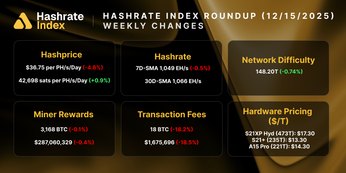
A Bitcoin Miner's Guide to Bitcoin Upgrades
Bitcoin miners--not just mining pools--need more insight into Bitcoin upgrades. Luxor is devising a playbook to give it to them.
When Bitcoin undergoes big upgrades that require a coordinated soft fork like Segwit or Taproot, there is no standardized process for advancing and activating the upgrade. For sure, there’s a system for proposing changes to Bitcoin with a Bitcoin-Improvement-Proposal (BIP), and a loose structure for reviewing the code: Bitcoin core contributors propose changes and other contributors review/edit the proposal. Most of these BIPs are for smaller changes to Bitcoin’s code that do not require a soft fork, so they are usually adopted seamlessly without much hubbub.
But some upgrades are such substantive changes that they require a soft fork–an upgrade that makes a change to Bitcoin’s fundamental rules where updated versions of the code are still compatible with older versions. These changes are very intensive and carry the risk of introducing vulnerabilities to Bitcoin’s code, so the wider Bitcoin community engages in scattered online debates to decide whether or not to adopt such changes to the Bitcoin protocol.
Each upgrade progresses at its own pace and is subject to its own set of unique challenges and needs. Once Bitcoiners have reached a rough consensus to move forward with an upgrade, activating it is another matter entirely, for which there’s also no set playbook.
It would behoove the Bitcoin community to refine this process. And it would certainly benefit miners, who often find themselves caught in the middle of upgrades, to educate themselves on future upgrades to contribute to global consensus and to understand their role (if any) in activating an upgrade.
Why Bitcoin Miners Need More Coordination to Assess Soft Forks
Luxor is committed to educating miners and Bitcoiners about new protocol upgrades and facilitating clearer lines of communications between Bitcoin developers and Bitcoin miners. Before we outline a strategy for navigating future upgrades, a quick recap of Bitcoin’s last two major soft forks and why they demonstrate the need for greater cooperation among Bitcoin’s many sectors.
We’ll start with Segwit, an upgrade that increases the amount of data you could include into each block. In 2016, the code was finalized, but a significant contingent of miners refused to upgrade because Segwit would cut into their transaction revenue. Bitcoin users forced miners’ hands by threatening a user activate soft fork, a scenario where active node users would adopt Segwit and blacklist blocks from any miners who hadn’t upgraded to it. The holdouts buckled and eventually adopted the upgrade.
The more recent Taproot was a more straightforward upgrade that didn’t see much opposition (if any). Still, to avoid another game of chicken like with Segwit, Bitcoin Core developers devised a polling method called Speedy Trial to gauge mining pool support for Taproot. If 90% of blocks in one 2,016 block difficulty period included a signal for Taproot (by tacking a number at the end of their block headers),the upgrade would receive enough consensus to “lock in.”

One criticism of Speedy Trial accused it of relying too much on a single sector of the Bitcoin ecosystem (Bitcoin mining) to decide on whether or not to move forward with the upgrade. Indeed, mining pool operators were asked to vote yes or no with Speedy Trial, but the individual miners themselves were left largely out of the loop. If Speedy Trial failed, some Bitcoiners spoke of activating Taproot themselves via a user-activated softfork.
Luxor took issue with how little time miners had to learn about Taproot before the signaling period started. This did not leave enough time for our miners to educate themselves on the proposed upgrade and voice any feedback or concerns. Indeed, in Taproot as in other upgrades, mining pools were treated as stand-ins for their entire client base, with no time nor processes in place to elicit educated opinions from their miners. It would be better for all miners (not just pool operators) to learn about an upgrade earlier so that they have a better understanding of it and its implications.
To be sure, miners are not necessary to enforce new protocol rules and soft-fork upgrades. But soft-fork activation can be much smoother if they are included in the process. Additionally, having miners take part in the activation process lessens the risk (however small) of a chain split.
A Bitcoin Miner’s Framework for Assessing Protocol Upgrades
Luxor is committed to liaising between Bitcoin miners and core developers so that our miners can better understand the ins-and-outs of future upgrades and a Bitcoin miner’s role, if any, in bringing them to fruition.
Our approach entails four stages: (1) Education, (2) Feedback, (3) Financial Support and (4) Signaling Support. In each stage, Luxor will:
1. Education
- Post updates on Hashrate Index for anything and everything in Bitcoin protocol development that miners need to know.
- Hold AMAs with key Bitcoin core contributors to give the community the opportunity to ask questions about proposed upgrades.
- Host educational conversations about upgrades with the Luxor mining community.
2. Feedback
- Provide ongoing feedback from our miners to Bitcoin Core devs and the Bitcoin community.
3. Financial Support
- Use a portion of our Bitcoin mining pool revenue to fund initiatives in the industry.
- Focus on bug bounties such, as our bounty for CTV (BIP-119)
4. Signaling Support
- Gather feedback from our mining pool participants and reach a consensus before pledging support for any future upgrade.
The majority of discussion for major Bitcoin upgrades takes place on the Bitcoin Core IRC chat. Some of this talk always spills over into other media like Twitter and Bitcointalk, but the bulk of the town-haul debating that drives protocol decisions occurs between Bitcoin Core contributors and other Bitcoiners on IRC. Often, this text-based banter is tangled with jargon and obscured by highly abstruse technical concepts that few Bitcoiners can comprehend at first glance.
As Bitcoin’s network grows beyond hundreds of millions of people, it will be critical to distill these technical changes into clear, layman’s language for Bitcoin’s expanding base of involved users. We may need to do this sooner rather than later, with Taproot and its Schnorr Signatures paving the way for future improvements to Bitcoin. Some of these include BIP-119 (CTV), BIP-118, cross-input signature aggregation, and BIP-300.
The above improvements would be win-wins for Bitcoin users and miners alike in terms of enriching Bitcoin’s smart contract capabilities, improving Bitcoin privacy tools like CoinJoin, and increasing Bitcoin’s on-chain financial use cases. With Bitcoin’s block reward trending to zero, miner revenues will become increasingly reliant on Bitcoin’s prices and transaction fees. Encouraging and supporting projects that utilize Bitcoin and increase transaction fees for miners will be essential for network health and security in the future.
As the Bitcoin network prepares for potential upgrades like those above, Luxor will be here to educate our miners and any other Bitcoiners on upcoming protocol improvements. We hope that other miners and Bitcoin companies will join us in shining a light on Bitcoin’s overshadowed but incredible open-source governance.
Hashrate Index Newsletter
Join the newsletter to receive the latest updates in your inbox.






